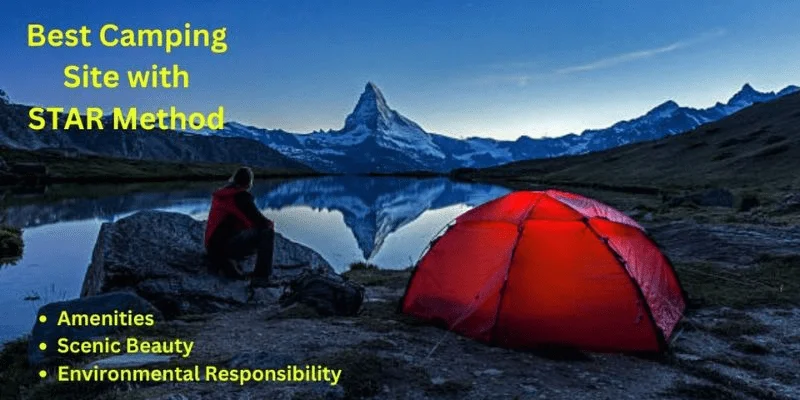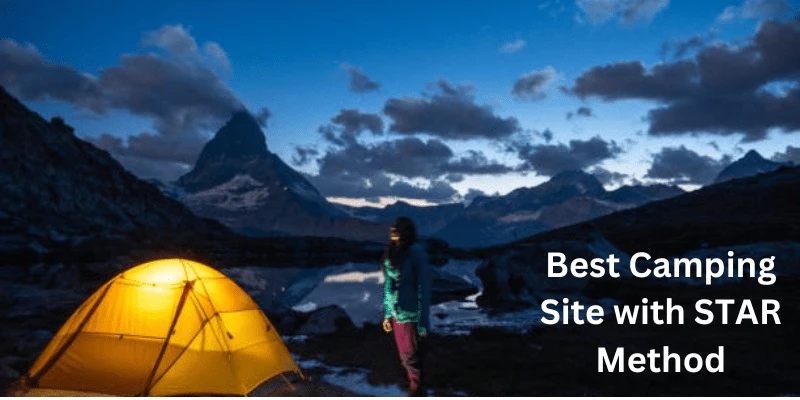Mastering the Hunt: 10 Steps for Discovering the Best Camping Site with STAR Method
Updated: 21 Mar 2024
184
Are you planning a camping trip but feeling overwhelmed by the countless options out there? Don’t worry, we’ve got you covered! Selecting the right campsite is crucial for a successful and enjoyable outdoor adventure. Best Camping Site with STAR Method is a step-by-step process. Now that you understand the STAR method, it’s time to put it into practice and find the perfect camping site for your next outdoor adventure.
Start by researching potential campsites in your desired area and use the STAR method to evaluate each option based on safety, terrain, accessibility, and resources. In this guide, we’ll introduce you to the STAR method for selecting the best camping location, a simple and effective approach to help you choose the perfect camping spot.
Features of Best Camping Site with STAR Method
Here are the features of the best camping site identified using the STAR Method:
1. Amenities
A top camping site may offer amenities such as picnic tables, fire pits, and designated cooking areas to enhance camper comfort and convenience. It may also provide access to recreational facilities, educational programs, or ranger-led activities to enrich the camping experience.

2. Scenic Beauty
An outstanding camping site showcases scenic beauty, with stunning views of natural landscapes, water features, or wildlife habitats. It allows campers to immerse themselves in the beauty of the outdoors and enjoy a sense of tranquility and connection with nature.
3. Environmental Responsibility
The best camping site promotes environmental responsibility, encouraging campers to minimize their impact on the ecosystem through practices such as Leave No Trace principles, waste reduction, and conservation efforts. It fosters a sense of stewardship and respect for the natural environment.
4. Community and Engagement
A top camping site fosters a sense of community and engagement among campers, providing opportunities for social interaction, shared experiences, and collaboration. It may offer communal gathering spaces, group activities, or educational programs to promote connection.
5. Safety Measures
The best camping site implements safety measures such as ranger patrols, emergency communication systems, and signage to ensure the well-being of campers and address any potential hazards or concerns promptly. It prioritizes camper safety and peace of mind throughout the camping experience.
Make a list of your top choices and consider factors such as proximity to attractions, availability of reservations, and any specific amenities or features that are important to you. Once you’ve narrowed down your options, visit each site if possible to assess conditions firsthand and ensure it meets your needs and preferences.
Steps for Finding the Best Camping Site for the STAR Method
Here are the steps to find the best camping site using the STAR Method:
1. Research Potential Campsites
Start by researching potential camping sites in your desired area. Look for options that align with your preferences and interests, such as wilderness camping, family-friendly campgrounds, or sites with specific amenities.
2. Safety Evaluation
Use the STAR Method’s safety criteria to evaluate each potential campsite. Look for areas that are free from hazards such as cliffs, unstable terrain, or wildlife habitats. Ensure that the site is safe for camping activities and minimizes risks to you and your fellow campers.
3. Terrain Assessment
Assess the terrain of each camping site to ensure it meets your needs. Look for level ground that is suitable for pitching tents and engaging in outdoor activities. Consider factors such as access to hiking trails, fishing spots, or swimming areas, depending on your interests.
4. Accessibility Check
Evaluate the accessibility of each camping site to determine how easy it is to reach. Consider factors such as proximity to parking areas, distance from amenities like restrooms and water sources, and any physical limitations that may impact your ability to access the site comfortably.
5. Resource Availability
Determine the availability of essential resources at each camping site. Look for access to water, firewood, and suitable areas for waste disposal. Consider natural resources such as shade, shelter, and protection from wind and rain to enhance your camping experience.

6. Compare and Contrast
Compare the pros and cons of each camping site based on the STAR Method criteria. Consider factors such as safety, terrain, accessibility, and resource availability to determine which site best meets your needs and preferences.
7. Select the Best Option
After evaluating all potential camping sites, select the one that best aligns with your criteria and preferences. Consider factors such as location, amenities, and the overall camping experience to make an informed decision.
8. Make Reservations
If necessary, make reservations for your chosen camping site in advance. Check availability and book your stay to secure your spot and avoid any last-minute disappointments.
9. Prepare and Pack
Once you’ve selected your camping site, prepare and pack accordingly for your outdoor adventure. Gather all necessary camping gear, food, and supplies, and ensure you’re well-prepared for your trip.
10. Enjoy Your Camping Experience
Finally, head out to your chosen camping site and enjoy your outdoor adventure! Take time to relax, explore nature, and make memories with friends and family. Embrace the beauty of the outdoors and cherish your camping experience.
Remember to plan and make reservations if necessary, especially during peak camping seasons. By using the STAR method to evaluate potential campsites, you can find the perfect spot to relax, unwind, and reconnect with nature on your next camping adventure.
Additional Tips for Choosing Camping Gear
Here are some additional tips for choosing camping gear:
1. Buy quality gear
Camping gear can be expensive, but it’s worth investing in quality gear that will last.
2. Do your research
Read reviews and compare prices before you buy any camping gear.
3. Consider your weight
If you’re backpacking, you’ll need to choose lightweight gear.
4. Practice using your gear
Before you go on your camping trip, practice setting up your tent and using your other gear.
Pros and Cons of choosing the best camping site using the STAR Method
The pros and cons of selecting the right site for ideal camping by using the Star Method are given below.
| Pros |
|---|
|
| Cons |
|---|
|
Overall, the pros of choosing the best camping site using the STAR Method outweigh the cons, as campers can enjoy a safe, comfortable, and memorable outdoor experience surrounded by nature’s beauty while minimizing its impact on the environment.
Additional Pieces of Information
In addition to the pros and cons outlined, here are some additional pieces of information to consider when selecting the best camping site using the STAR Method:
- Seasonal Considerations
- Local Regulations
- Wildlife Awareness
- Emergency Preparedness
- Leave No Trace Principles
- Respect for Others
- Weather Preparedness
- Camping Gear Essentials
- Local Attractions and Activities
- Feedback and Reviews
By considering these additional pieces of information along with the STAR Method criteria, you can choose the best camping site for your next outdoor adventure and enjoy a memorable and rewarding experience in the great outdoors.
FAQs
What is the STAR Method for choosing a camping site?
The STAR Method is a framework used to evaluate potential camping sites based on four key criteria: Safety, Terrain, Accessibility, and Resources. It helps campers assess different aspects of a camping site to determine if it meets their needs and preferences.
How do I use the STAR Method to find the best camping site?
To use the STAR Method, begin by researching potential camping sites in your desired area. Evaluate each site based on safety considerations, terrain features, accessibility, and available resources. Compare the pros and cons of each site to determine which one best aligns with your criteria and preferences.
What factors should I consider when evaluating safety at a camping site?
When assessing safety, consider factors such as potential hazards like steep cliffs or unstable terrain, proximity to wildlife habitats, and access to emergency services. Choose a camping site that minimizes risks and ensures a safe environment for outdoor activities.
How important is terrain when choosing a camping site?
The terrain is crucial for a comfortable camping experience. Look for level ground that is suitable for pitching tents and engaging in outdoor activities. Consider access to hiking trails, fishing spots, or swimming areas depending on your interests.
What does accessibility entail when selecting a camping site?
Accessibility refers to how easily you can reach the camping site and navigate within it. Consider factors such as proximity to parking areas, distance from amenities like restrooms and water sources, and any physical limitations that may impact your ability to access the site comfortably.
How can I ensure a positive camping experience using the STAR Method?
By carefully evaluating potential camping sites using the STAR Method criteria, you can choose a site that meets your needs and preferences. Consider factors such as safety, terrain, accessibility, and available resources to ensure a memorable and enjoyable outdoor adventure.
Conclusion
Choosing the best camping site doesn’t have to be a daunting task. By using the STAR method to evaluate potential campsites based on safety, terrain, accessibility, and resources, you can find the perfect spot for your next outdoor getaway. Whether you prefer a secluded wilderness retreat or a family-friendly campground with all the amenities, this simple approach will help you find the ideal camping site for your needs and preferences.
It provides a valuable framework for selecting the best camping site and ensuring a memorable and rewarding outdoor experience for campers of all ages and experience levels. By using this approach, campers can embark on their next camping adventure with confidence, knowing they’ve chosen the perfect spot to create lasting memories in the great outdoors.
Please Write Your Comments